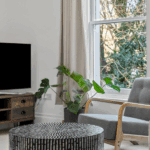Functional interior design.
When people think about interior design, they often picture beautiful colours, stylish furniture, and curated accessories. And yes — those are all important! But at the heart of every great design is something even more essential: function.
A room can be gorgeous, but if it doesn’t work for the way you live, it won’t feel quite right. That’s why I always start with how a space is used, before diving into the style. Because the truth is, you can absolutely have both.
Why function comes first
Good design supports your everyday life. Whether that’s cooking for your family, working from home, hosting friends, or simply wanting a quiet corner to enjoy your morning coffee — your space should work for you, not against you.
I often speak to people who feel frustrated with how their home works. Maybe their living room has no storage, or the kitchen feels cramped even though it’s a good size. These things aren’t always about how many square meters you have — they’re about smart design.
That’s where function comes in. It’s not glamorous, but it’s the foundation that makes everything else shine.
How I design for everyday life
Designing for function means looking at:
- How the room is used (and by who!)
- Layouts that make daily life easier
- Storage that doesn’t scream “storage”
- Furniture that’s as practical as it is beautiful
- Lighting that suits different moods and times of day
- Durable, easy-to-clean materials that still look lovely
For example, in my Complete house renovation – St Leonards, the clients struggled with a lack of storage and the spaces were all disjointed from each other with no heart to the home. We addressed the flow throughout the house by opening up the kitchen and living room and custom-built units were designed to offer discrete storage. The result? A home that flows seamlessly from room to room, combining functionality, storage solutions, and high-end design touches.
The perfect example of functional interior design: blending style with practicality!
But let’s not forget style
Now, don’t get me wrong — I love the styling side of design. And just because something’s practical doesn’t mean it can’t be beautiful. The magic happens when the two meet.
You can have:
- Easy-clean fabrics (perfect for pets and children) that still feel luxurious
- Hidden storage that blends into your aesthetic
- Durable finishes that add character
- Lighting that’s both functional and atmospheric
It’s not about choosing style or function. It’s about creating a space where they work together seamlessly.
3 simple ways to get the balance right
So my top tips on how you can achieve this…
- Start with how you live
Think about your daily routines and what frustrates you in your current space. That’s your design brief right there - Choose pieces with purpose
Every item in a room should earn its place — either by being useful, beautiful, or ideally both - Don’t design for trends
Your home should feel like you, not like a showroom or Pinterest board. That’s where real comfort lives.
Final thought: design that feels right
When design is both functional and stylish, it just feels right. Things flow better. Life’s easier. You enjoy your home more.
And that’s what I’m here to help with — creating spaces that reflect your lifestyle and personality, while working beautifully behind the scenes.
Fancy a chat about how I can help with your space? Book your free 30-minute discovery call here.
This blog is part of my “Back to Basics with Interior Design” series, where I’ll share tips to help you create spaces that are functional, stylish, and personal. See previous posts and stay tuned for the next post: The importance of texture and layering in interior design.


